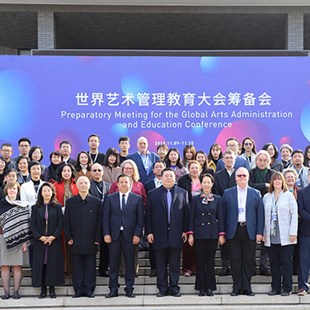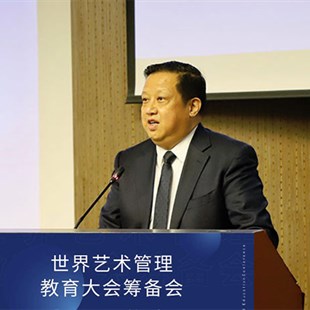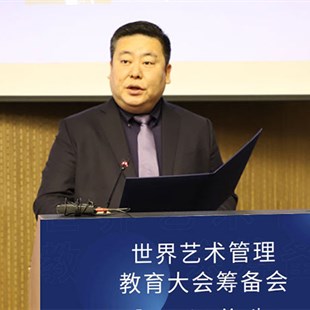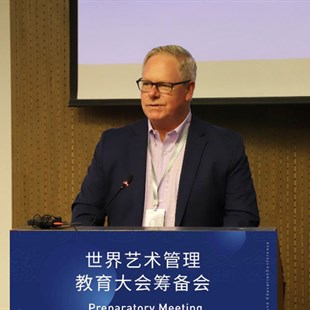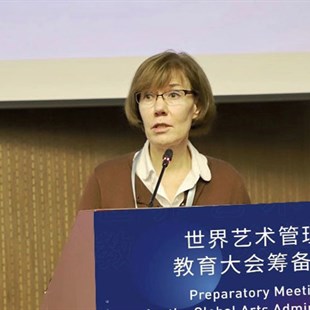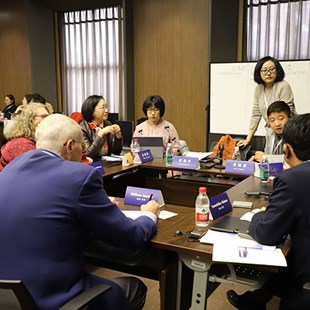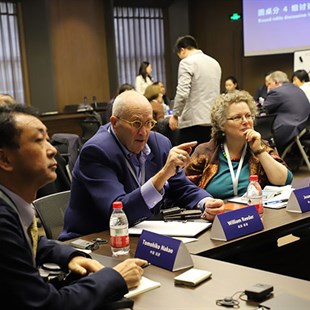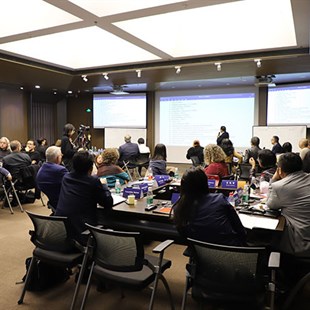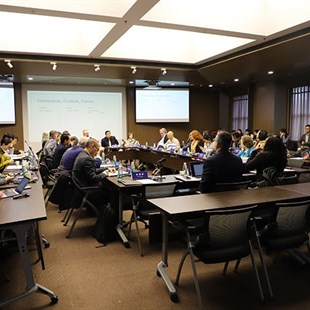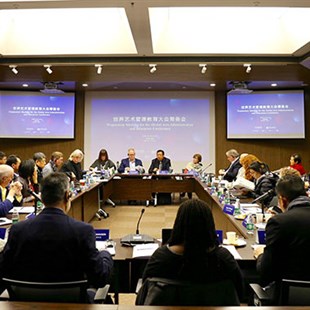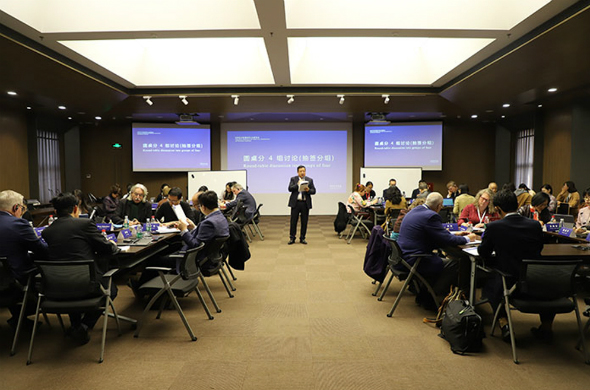
During the course of development for almost half a century, global arts administration education has come step by step from “exploration” to “development”, from a “major” to a “discipline”, from “regionality” to “integration”. The exploration of the discipline of arts administration began in the 1950s in Europe and North America, while in China the subject was born in 1983 from “Arts Administration Specialized Training Class” organized by Shanghai Traditional Opera School and from the Teaching and Research Office of Culture Management formed by the Central Institute for Culture Management. China’s development of arts administration relies on the China Association for Arts Administration Educators (CAAEA) established in 2006, which leads institutions of higher education to develop and explore the discipline of arts administration.
The Preparatory Meeting for the Global Arts Administration and Education Conference was held at the Central Academy of Fine Arts from November 9 to November 10, 2019, with more than 60 attendees from 31 universities and academic organizations around the world. The preparatory meeting was jointly organized by the Central Academy of Fine Arts and China Conservatory of Music, with strong support from CAAEA, the Association of Arts Administration Educators (AAAE), the European Network on Cultural Management and Policy (ENCATC), and the Canadian Association of Arts Administration Educators (CAAAE).
Wang Xiaolin, Standing Committee Member of Party Committee and Vice President of the Central Academy of Fine Arts, delivered the opening speech at the meeting. Professor Yu Ding hosted the opening ceremony, who is the academic organizer of the meeting, Dean of Arts Administration and Education Department of CAFA, and President of China Arts Administration and Education Association. Kevin Ken Maifeld (President of AAAE), Ana Gaio (Vice President of ENCATC), Richard G Maloney (Secretory-General of ENCATC and former board member of AAAE), and Sherri Helwig (President of CAAAE) delivered speeches respectively as representation of their associations, and expressed hope for long-term cooperation, in expectation for countries around the globe to facilitate development of arts administration education with joint efforts.
Origins of the Global Arts Administration and Education Conference
China’s current need to develop the subject of arts administration comes first paying attention to the origins. With the economic and cultural development of China, the demands for international cultural exchange and cooperation increase day by day, and it’s urgently required to cultivate high-quality talent in arts administration.
Secondly, the conference was driven by the efforts of CAAEA. During the 2019 AAAE seminar at University of Wisconsin-Madison, President of CAAEA Professor Yu Ding, discussed the proposal of co-hosting “Global Arts Administration and Education Conference” with the new board of AAAE and new board members of ENCATC, and they agreed on organizing the Preparatory Meeting for the Global Arts Administration and Education Conference in China in November 2019.
Besides, internal demands arising from the development of arts administration in China over the past 30 years contributed to the progress of the Global Arts Administration and Education Conference. Themed academic conferences, forums, and international exchanges have become an important driving force for the development of arts administration in China.
Lastly, it depended on the support, investment, and perfect execution of the hosting party. This preparatory meeting was jointly hosted by the Central Academy of Fine Arts and China Conservatory of Music, with strong support from CAAEA, AAAE, ENCATC, and CAAAE, that assigned their presidents, principals, and representatives to attend the meeting.
Interpret “Four Themed Modules” of the Preparatory Meeting
The preparatory meeting was organized for the Global Arts Administration and Education Conference in 2020, aimed at determining themes for the debut conference, topics of sub-forums, the organizational structure and forms of the assembly. The preparatory meeting has four agendas: roundtable discussions, grouping by drawing and developing keywords, interpreting keywords and exchanging, and the meeting summary.
The keywords of four modules are confirmed as “Methodology”, “Borderlines of Disciplines”, “Practices”, and “Future Expansions”, reflecting urgent and present questions that need to be discussed and resolved in terms of arts administration and education.
I. Methodology
The methodology emphasizes the ways and approaches to observe, research, and handle questions related to arts administration, in order to achieve reaffirmation of the academic standards of arts administration nowadays and reflect the diverse new meanings derived within arts administration in the changing social context. The current standards of arts administration show different characteristics in different regional educational systems. Through discussions about methodologies of arts administration, we can lead arts administration and education to more systematic and rational development.
II. Borderlines of Disciplines
Borderlines of the discipline of arts administration not only concern the new definition of arts administration nowadays but also emphasize its potential connections to and influence from other disciplines in future society. Arts administration includes a range of art categories and is a cross-disciplinary major with diverse subjects. The discussion about its borderlines will benefit the extension and growing dimensions of the subject. Currently, there exists differentiation and imbalance of educational resources and environments around the world, and this discussion around borderlines of disciplines will have a prospective effect on the subject development in the future.
III. Practices
The practice is one of the key features of arts administration, and is also an important manifestation of social value and meaning produced by arts administration. Arts administration can only show its characteristics and specific content through practices The practice of arts administration is to master a large number of specific skills and approaches, and to apply them perfectly to practices through management and other measures. In the development of arts administration, despite numerous excellent and classic case studies, our focus is on how to take advantage of new technologies and media skills so as to practice more innovative arts administration with a new cultural and technological background.
IV. Future Expansion
Where does the future lead, what is the future of arts administration? The future is a common topic of any discipline, and the purpose and driving force of arts administration is to fulfill the learning and working needs of current and future students of arts administration. This includes exploration of global art ecology in the future, and of new technologies and fields related to arts administration. Future expansion will consider directions and fields of study in the long term, and provide crucial references to current development and design of the discipline.
24 keywords, Explaining Current Topics of Arts Administration
During the Preparatory Meeting for the Global Arts Administration and Education Conference, more than 60 attendees from 31 universities and academic organizations around the world brought up 68 keywords after initial discussions, and selected 24 keywords based on further discussions and a voting process, which serves as important topics for the Global Arts Administration and Education Conference in 2020.
24 Keywords
1. Sustainability
2. Critical analysis
3. Professional practice as research
4. Curriculum standard
5. Technology/media/internet
6. Art law/Cultural policy and governance
7. Leadership
8. Local and global
9. Standards or frame methods (scientific, artistic)
10. Interculturality
11. Comparative practice and research
12. Strengthening of International exchanges
13. Community connections
14. Tradition sand contemporary
15. Art administration for social innovation/capability of innovation
16. Multi-culture in arts administration education
17. Equity and inclusion
18. Cultural/social/economic impact made by arts administrators
19. Employability
20. Marketing and audience development
21. Art world and definition and arts administration
22. Pedagogy
23. Digitization/AI
24. Interdisciplinary
The 24 keywords of arts administration specify the related fields in the present, and within the territory, gradually build up more comprehensive and systematic global standards of arts administration and education.
The Preparatory Meeting for the Global Arts Administration and Education Conference not only brings China’s current development of arts administration and education to a global context, but also leads global arts administration and education into a new discussion. The success of the preparatory meeting also laid a perfect foundation for the Global Arts Administration and Education Conference in 2020.
Text by Lin Lu, translated by Yuting He and edited by Sue/CAFA ART INFO
References:
1. Related materials from the preparatory meeting.
2. Yu, Ding.Introduction to Arts Administration M. Higher Education Press, 2008.
3. Benvenu, Beth M.Core Consensus, Strategic Variations: Mapping Arts Management Graduate Education in the United States. 2013.


